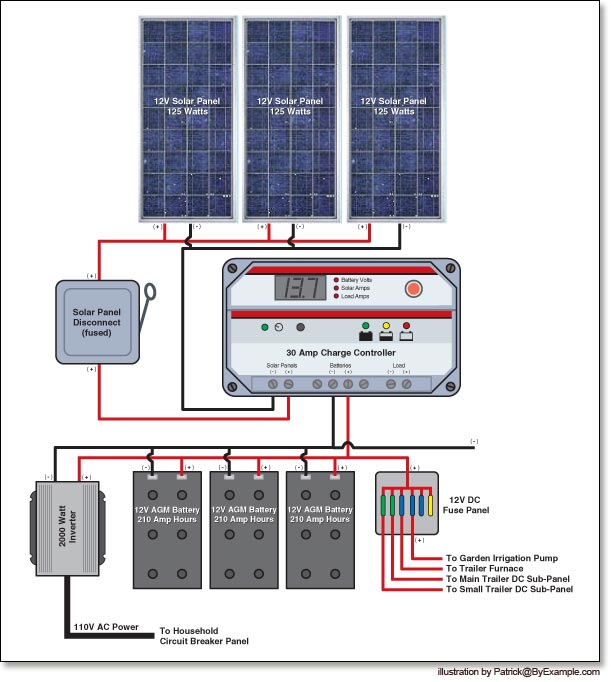375 Watt Solar Power System
Our 375 watt solar power system consisted of three solar panels, three AGM batteries, a 30 amp charge controller and a 2000 watt inverter. This particular system was upgraded 3 times in our first year here, as we added to it piece by piece. It's configuration eliminated many inefficiencies present in earlier setups. We're always learning...
For over a year this system powered all of our home electricity needs including computers, microwave, forced air furnace (propane heated), small kitchen appliances, charging portable batteries, small power tools, water pressure pumps, etc.. Even with our modest solar system, we never ran out of power. However, after three days of cloudy weather we have found that being conservative with our power usage is the best course of action. Most days and nights we have had comfortable use of power as needed. Since there are so many more sunny hours in the summer and we don't need to run the heat (that's a fair amount of power) the summer has always been much easier when it comes to power.

In this system the three solar panels (12 volts, 125 watts each) are wired in parallel so that the voltage remains 12 volts and their power output is combined to a total of 375 watts. This array of panels is then connected via 20 feet of 10 guage, sun resistant romex to the charge controller. There's a fused disconnect between the Panels and the Charge Controller (positive lead only) so that the panels can be switched off in the case that the Charge Controller needs maintenance or repair.
The charge controller is the "brains" of the solar power system. It monitors the batteries and the incoming power from the solar panels and intelligently directs and controls the flow of electricity into the batteries. As batteries come closer to being full, they must be charged more slowly or they will overheat and/or boil over (which damages your batteries).
Batteries store power for use when the sun isn't out. We're using 3 210 Amp Hour AGM batteries that give us a total of 630 Amp Hours of power storage. With most deep cycle batteries it's a good practice to only drain your batteries to "half" the power level. That's just over 300 Amp Hours of available power. At our normal usage of power that should last us 3 to 5 days should there be no incoming power from the panels. The batteries are connected to one another and the charge controller via 2 guage wire.
The inverter is tied directly to the batteries at the end of the 2 guage battery wire. The inverter converts the 12 volt DC electricity into 110 volt AC (standard household voltage) so that we can run basic home appliances. At present we are using a 2000 watt modified sine wave inverter -- that's about a max of 18 amps of 110 volt AC electricity.
All DC Loads are tied into the DC fuse panel. Our pressure pumps, furnace fan, lights, electronic controls on the propane refrigerator all run off of 12 volt DC electricity. The fuse panel sub-divides and individually fuses the various circuits much like the circuit breaker box in the average home. Our DC fuse panel uses the same type of fuses commonly found in automobiles today.
Going Solar?
To read more about our perspective on off-grid living and the need for sustainability click here.
To see the diagram of our current solar power system click here.